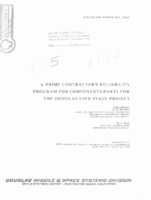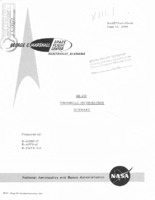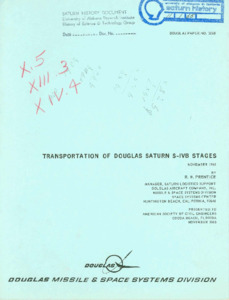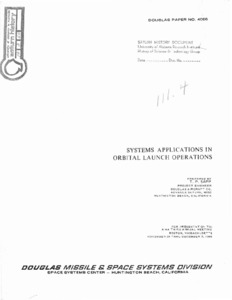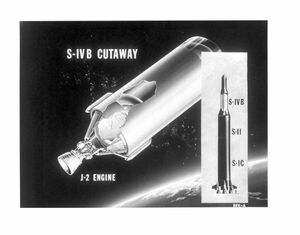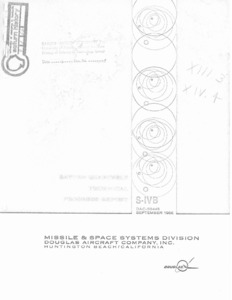
Browse Items (16 total)
Sort by:
-
Volume II Appendices for the Saturn V Derivative Launch Vehicle System Study.
According to the table of contents, this volume of appendices contain various charts, graphs, and diagrams related to the S-IC stage data, instrument unit data, and vehicle data. -
"A Prime Contractor's Reliability Program for Components/Parts for the Douglas S-IVB Stage Project."
This paper, presented at the fifth annual Reliability and Maintainability Conference in New York City, contains a "prime contractor's reliability program for components/parts for the Douglas S-IVB stage project." These parts include special flight critical items and their complementary reliability engineering program plan is outlined in this paper. -
"AS-203 Technical Information Summary."
"This report outlines, through a series of sketches with accompanying text, the general features of the SA-203 Launch Vehicle and information on launch preparation, the launch facility and mission peculiar experiments." -
"Transportation of Douglas Saturn S-IVB stages."
Presented to the American Society of Civil Engineers by R. W. Prentice, manager, Saturn Logistics Support, Douglas Aircraft Company Inc., Missile & Space Systems Division, Space Systems Center, Huntington Beach, California. This paper describes the significant events and equipment associated with transporting the Douglas Aircraft Company, Inc., built Saturn S-IVB stage from stage fabrication at Huntington Beach, California, to the Sacramento Test Center and to the Kennedy Space Center. Descriptions and illustrations of the transportation vehicles and major ground support and instrumentation equipment are presented for a more comprehensive understanding of the transportation problem. -
"The development of a bonded common bulkhead for Saturn."
A Part of the development of the Saturn S-IV/S-IVB stage the Douglas Aircraft Company has pioneered in the development of the cryogenic common bulkhead. The term common bulkhead is derived from the design function of the bulkhead, which is to separate the two cryogenics, liquid hydrogen and liquid oxygen, in a single tank, thereby shortening the stage and eliminating the necessity for two separate bulkheads and the associated interstage structure. The common bulkhead is structurally adequate to withstand both the thermal and the pressure loads from both the hydrogen and the oxygen tanks, and it has sufficient insulation properties to prevent the liquid hydrogen from freezing the liquid oxygen. Another benefit from the common bulkhead is that it permits a reduction in the total length of the vehicle, thereby reducing the bending moments. -
"Systems applications in orbital launch operations."
The objective is to examine the technical requirements and feasibility of conducting orbital launch operations with systems now in the development phase. In order to maintain realistic constraints on the analysis, the Saturn S-IVB stage has been used as an example of present stage technology. The requirements, procedures and complexity of operations for orbital assembly and launch are discussed. The primary design requirement for orbital assembly and launch operations is increased orbital stay time (from hours to days or weeks). -
S-IVB cutaway and J-2 engine."
8 x 10 inch black and white diagram of the JII engine and the Saturn IV. -
"Saturn S-IVB quarterly technical progress report."
Douglas Aircraft Company Report DAC-56445, Saturn S-IVB Quarterly Technical Progress Report, covers design and development progress on the Saturn IB and Saturn V configurations of the S-IVB stage during August and September 1966. This report is prepared for the National Aeronautics and Space Administration under Contract NAS7-101. -
"The role of the S-IVB in the Apollo and past Apollo programs."
Douglas Paper No. 4396.; Prepared by Ludwig Roth, Director, Saturn/Apollo Program Extension, Douglas Aircraft Company.; Presented to 16th Annual Conference of the Hermann Oberth Society. Discusses the role of the Apollo rocket after the Apollo program has concluded. -
"Redundancy employing majority voting for a Saturn servoactuator."
R-ASTR-NF.; ABSTRACT: The servoactuator was developed to improve the reliability of the Saturn S-IVB thrust vector control system by insuring continued system operation if single point failures occur. The selection of the majority voting technique is discussed. Its simplicity is cited along with the advantages of minimum weight, size, power consumption, and compatibility with existing control electronics. Operational features, design mechanization, and the analysis of test results are covered.

